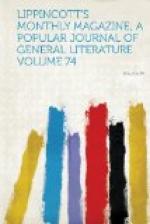The great standard of the republic of Tlascala was richly ornamented with emeralds and silver-work. The fantastic helmets of the chiefs glittered with gold and precious stones, and their plumes were set with emeralds. The mantle of Montezuma was held together by a clasp of the green chalchivitl (jade), and the same precious gem, with emeralds of uncommon size, ornamented other parts of his dress.
The Mexicans carved the obdurate jade and emerald with wonderful skill, using, like the Peruvians, nothing but silicious powder and copper instruments alloyed with tin. They also worked with exquisite taste in gold and silver, and they represented Nature so faithfully and so beautifully that the great naturalist Hernandez took many of these objects thus portrayed for his models when describing the natural history of the country.
When Cortes returned home he displayed five emeralds of extraordinary size and beauty, and presented them to his bride, the niece of the duke de Bejar. On his famous expedition along the Pacific coast and up the Gulf of California he was reduced to such want as to be obliged to pawn these jewels for a time. One of them was as precious as Shylock’s turquoise, and Gomara states that some Genoese merchants who examined it in Seville offered forty thousand golden ducats for it. One of the emeralds was in the form of a rose; the second in that of a horn; the third like a fish with eyes of gold; the fourth was like a little bell, with a fine pearl for a tongue, and it bore on its rim the following inscription in Spanish: “Blessed is he who created thee!” The fifth, which was the most valuable of all, was in the form of a small cup with a foot of gold, and with four little chains of the same metal attached to a large pearl as a button: the edge of the cup was of gold, on which was engraved in Latin words, “Inter natos mulierum non surrexit major.” These splendid gems are now buried deep in the sand on the coast of Barbary, where they were lost in 1529, when Cortes was shipwrecked with the admiral of Castile whilst on their way to assist Charles V. at the siege of Algiers.
The quantity of emeralds obtained by the Spaniards in their pillage of Mexico was large, but it was trifling when compared with that collected by Pizarro and his remorseless followers in the sack of Peru. Many large and magnificent stones were obtained by the Spaniards, but the transcendent gem of all, called by the Peruvians the Great Mother, and nearly as large as an ostrich egg, was concealed by the natives, and all the efforts of Pizarro and his successors to discover it proved unavailing.
The immense uncut Peruvian emerald given by Rudolph II. to the elector of Saxony is still preserved in the Green Vaults at Dresden. This collection is the finest in the world, and is of the value of many millions of dollars. The treasures are arranged in eight apartments, each surpassing the previous one in the splendor and richness of its contents. This museum dates from the early period when the Freyburg silver-mines yielded vast revenues, and made the Saxon princes among the richest sovereigns in Europe. With lavish hand these potentates purchased jewels and works of art, and the treasures they have thus accumulated are of immense value, and remind the traveler of the gorgeous descriptions of Oriental magnificence.




